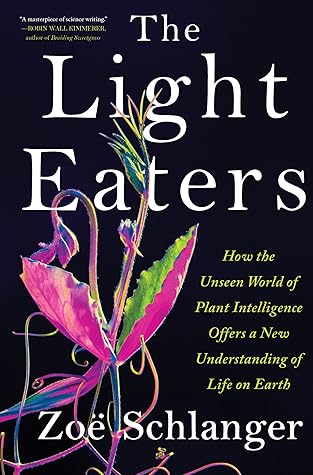More on this book
Community
Kindle Notes & Highlights
Read between
May 1 - May 12, 2025
The experience of flashes of the eternal, the real, the gestalt, runs like a thread throughout naturalist literature. I wasn’t the only one who had been taken like this before.
Each time I caught a creature in an act of unrestrained creatureliness, I felt I’d stolen a glimpse behind the curtain, into their world. The real world.
By incessantly breathing out, those legions of early land plants tipped the balance of gases toward oxygenation. They created the atmosphere we now enjoy. It’s not a stretch to say they birthed the habitable world. As the Italian philosopher Emanuele Coccia puts it, they constructed our cosmos; “The world is, above all, everything the plants could make of it.”
He doesn’t take Prozac, like some of the other rare-plant botanists he knows. Instead, he writes poetry. Either way, Perlman tells me, you have to do something when a plant you’ve long known goes extinct. Each plant that dies that singularly lonely death marks the end of a multimillion-year evolutionary project. That species’ great genetic experiment is over; it’s the last in its line.
This state of unseeing has become a named affliction, lamented among botanists: “plant blindness,” the tendency to view plant life as an indistinguishable mass, a green smudge, rather than as thousands of genetically separate and fragile individuals, as distinct from one another as a lion is from a trout. The term shows up in research papers and at conferences where worried scientists wring their hands over how to get the public to even see the subjects of their life’s work. For botanists, plant blindness amounts to a perennial struggle to get basic research funded, or to convince anyone that
...more
I realized part of the problem was the way the pieces of information all came wrapped in layers of hedging, language that distances plants from ourselves at all costs. Calling the vasculature of a plant its nervous system could change that. I thought of Theophrastus, and his wisdom that humans needed metaphors they could connect to. The core of a tree should be called the heartwood, he said. No one has ever looked at heartwood and expected to find the vena cava. Yet it works to call to mind the right meaning: here is the tender flesh that keeps the tree alive. And here too are the channels
...more
There is something decidedly queer in all of this—the orchids and aspens and strawberries and antplants and ginkgoes—a sense of sensual entanglement that disregards binaries, runs across the species boundary, and almost gleefully defies heteronormative modes of reproduction. This lens might also help us escape the idea that everything in nature is a battle, with a clear winner. Sometimes it may be an improvisation, or a collaboration, or something else entirely.
Either way, it seems time to dim the lights on the idea of plants as individual entities with neat borders. Where a plant starts and stops is not clearly understood. It may not even be a useful question. Ignoring the many ways plants and their collaborators interact—and, ultimately, constitute the plant itself—leaves us with a very partial view of reality. Plants are composites of interpenetrating forms of life that resist an either-or classification. Perhaps much like us.
Consider the emerald green sea slug. When I first read about it, I couldn’t stop talking about it with anyone who asked what was going on with me lately. The green sea slug, this whimsical thing that seemed to defy all boundaries between plant and animal, was going on with me. It was all I could think about.
Nadeau was able to infer that the genes of her patients—who lived in Fresno, in California’s Central Valley, the most polluted city in the state, due to a deadly combination of diesel exhaust and agricultural pesticides—were fundamentally altered so that they would be more likely to develop asthma and allergies. And those genetic changes could be passed down to their children, and their children’s children, even if those later generations had moved away and were no longer exposed to the pollution.
Respect comes with a certain responsibility of care, of maintaining a good relationship. Plant personhood may be something we have to teach ourselves, and perhaps we initially strain to see it. But once seen, the care part of that new awareness comes quite naturally. You might find you respect the autonomy of plants not because you know you “should,” but because you know you must. Because doing otherwise would violate your own moral personhood. It is a bridge to cross, from plant disregard to plant regard. The distance between the two is the orientation of one’s heart on the subject.


